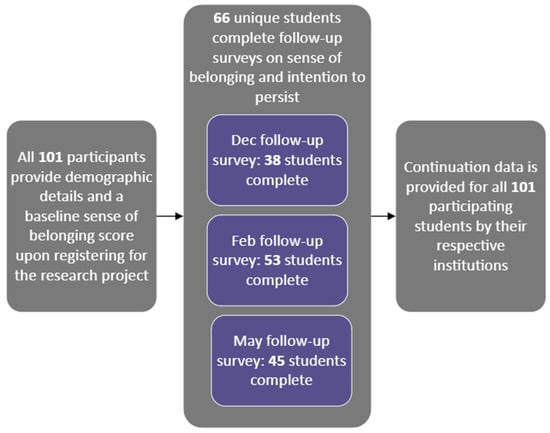4.2. To What Extent Is Students’ Sense of Belonging a Predictor of Students’ Intention to Persist?
Given that they were measured by separate scales, little focus should be given to the fact that intention to persist was consistently greater than students’ sense of belonging at all measurement points. Whilst, the questions in each scale were devised using the same Likert scale—from strongly disagree to strongly agree—they are different scales. Instead of focusing solely on absolute values, instead more insight can be gained by exploring changes over time. Through this lens, it is clear that both students’ sense of belonging and intention to persist decreased slightly on average through the first academic year of study.
The strength of the connection between these two constructs is explored further through the use of linear regression analyses. Given the longitudinal nature of this study, there are multiple ways to assess the connection between student belonging and intention to persist through regression analyses. Four connected analyses were conducted to explore this looking at the strength of the relationship between the following:
- Belonging and intention to persist at each survey measurement point (Table 3)—to explore whether the relationship between the variables is stronger or weaker at certain points in the year;
- Students’ sense of belonging and intention to persist at the next survey measurement point (Table 5)—to explore whether the sense of belonging is a reliable predictor of future intention to persist. This could then indicate how belonging could be used as a lead indicator of intention to persist—in a similar way to how intention to persist is seen as a lead indicator of continuation itself;
- Change in students’ sense of belonging against change in students’ intention to persist (Table 6)—to explore whether efforts to affect students’ sense of belonging could be expected to have corresponding shifts in students’ intentions to persist.
Given that belonging and intention to persist were strongly correlated within each survey measurement point, it perhaps could be expected that the relationship between the average values for these two constructs would be similarly high. In fact, the average sense of belonging was almost a perfect predictor of students’ average intention to persist (β = 0.989, p < 0.001, n = 66).
Whilst not true for all constructs measured in surveys, there is a risk that the extremely high correlations between these variables could be explained by common method bias, as students were completing their questions about the sense of belonging and intention to persist within the same overarching questionnaire. There is a risk of acquiescence bias: if students had been responding positively to the questions about belonging, then this could have primed them to also respond more positively to all subsequent questions: those around intention to persist.
Overall, this suggests that students’ sense of belonging is positively correlated with their intention to persist at an overall average level and at each individual time point. Sense of belonging is also a predictor of future intention to persist, as measured through the relationship between any belonging measurement and the intention to persist measurement for that same student within the next survey—for example, students’ sense of belonging in December being able to predict students’ intention to persist scores in February.
Given the strength of the relationship between belonging and intention to persist, an immediate question to explore would be whether the two scales are just measuring the same constructs. Whilst most of the questions in the Yorke belonging scale do not appear related to the questions included within the intention to persist scale, there is one that has the risk of conceptual overlap. The question: “I wish I’d gone to a different university (reversed scale)” does seem at least somewhat conceptually related to the questions being asked in the intention to persist scale, as it is asking students to reflect on whether they perceive regret in choosing their current university of study. This is not asking the same thing as any of the questions in the intention to persist scale, as it is asking the student to reflect rather than asking about their commitment to make a forward-looking decision that would involve them leaving their current university. However, it is somewhat conceptually related as a question to the intention to persist scale. How this potential conceptual overlap should be addressed is included in the discussion section of this article. Another possible explanation is that both a sense of belonging and an intention to persist may reflect deeper psychological traits within participants, which explains why they are so closely correlated over time.
4.3. To What Extent Is Students’ Sense of Belonging a Predictor of Continuation?
Similar to the previous section of this article, this research question was explored through a combination of data visualisation and regression analyses. Unlike the intention to persist, whether students continue in their studies or not is a binary variable. Therefore, binary logistic regression has been utilised to explore the strength of the relationship between this outcome variable and students’ sense of belonging. As noted within the methodology section of this article, average marginal effects have also been calculated and included within the regression tables to support meaningful interpretation of the strength of relationships.
This visualisation of students’ sense of belonging, split by students’ eventual continuation status, begins to show that there is a clear connection between these variables. Interestingly, the average October survey measurements for belonging are almost the same across the continuation split. This suggests that this October measurement of belonging was no indicator of students’ eventual continuation status. However, all subsequent average measurements of belonging show a clear separation between those who continued and those who did not.
Overall, these results strongly suggest that students’ sense of belonging is a significant predictor of students’ eventual continuation. However, two important caveats to this are that students’ measurement at the start of the academic year—in October—was not significantly associated with students’ eventual continuation, and neither was students’ change in sense of belonging.
Source link
David Gilani www.mdpi.com


